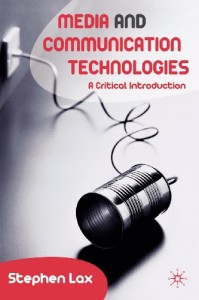Media and Communication Technologies: A Critical Introduction by Stephen Lax (Palgrave Macmillan, 2008). 248 pages. ISBN-13: 978-1403998903 (paperback), £22.99
 About the reviewer: Dr Natasha Whiteman teaches in the Department of Media and Communication at the University of Leicester where she is also currently the Research Ethics Officer and the PG Admissions Tutor. Her PhD explored the workings of two online fan sites over a two-year period. Using text analysis of posting activity, this work presented a sociological analysis of the patterning of consumption and identification with fan objects demonstrated on the public forums of these sites, and how these are related to the ways that participants learn to be successful community members/successful fans. The PhD was funded by the ESRC and is available to download here. Her latest book is Undoing Ethics: Rethinking practice in online research (2012);
About the reviewer: Dr Natasha Whiteman teaches in the Department of Media and Communication at the University of Leicester where she is also currently the Research Ethics Officer and the PG Admissions Tutor. Her PhD explored the workings of two online fan sites over a two-year period. Using text analysis of posting activity, this work presented a sociological analysis of the patterning of consumption and identification with fan objects demonstrated on the public forums of these sites, and how these are related to the ways that participants learn to be successful community members/successful fans. The PhD was funded by the ESRC and is available to download here. Her latest book is Undoing Ethics: Rethinking practice in online research (2012);
This introduction to the history of media and communication technologies provides somewhat of a wakeup call for those fixated on the rapid developments of today’s media environment. Amongst the media’s apparent obsession with the 'twitterati' and the perils of Facebook, it is sometimes easy to forget that older technologies were once as revolutionary as those which surround us now and provoked similar reactions. Lax warns against such forgetfulness in the introduction, where he states that 'If the history of a particular technology is an important part of explaining how thing are done today, it is also a useful check on the frequent proclamations that all technological systems we see before us today are completely unprecedented and herald a new era.'
Informed by this historical perspective, the book presents a survey of the development of a range of technologies, moving from a description of early forms of communication to the present day, taking in along the way radio, television, cable and digital broadcasting, computing and convergence, and mobile communications. The book closes with a very useful assessment of debates surrounding the so-called 'information society.'
 As he moves broadly chronologically through this history, Lax’s central focus is in describing how the emergence of these technologies has always been shaped by broader social, political and cultural developments. In setting out these interconnections, Lax develops a critical approach to the study of technologies as 'social products' that 'have technological features that constrain or otherwise help explain the consequences of their use and their subsequent development.' Clear and accessible explanations of these features are presented to the reader throughout the book, often illustrated by helpful diagrams and tables.
As he moves broadly chronologically through this history, Lax’s central focus is in describing how the emergence of these technologies has always been shaped by broader social, political and cultural developments. In setting out these interconnections, Lax develops a critical approach to the study of technologies as 'social products' that 'have technological features that constrain or otherwise help explain the consequences of their use and their subsequent development.' Clear and accessible explanations of these features are presented to the reader throughout the book, often illustrated by helpful diagrams and tables.
It is in the details of the missteps, unexpected take-ups, successes and failures that occurred during the development of these technologies that I think the book provides its most interesting content. Events reveal the sometimes peculiar uses to which technologies were put (such as the early use of the telephone as a broadcast medium in relaying concerts and church services to subscribers), and the tragedies that they were bound up with (such as the relationship between the sinking of the Titanic and the regulation of wireless telegraphy). The author adds texture to his account through the use of historical source evidence including newspaper reports and letters to the editor. The dramatic nature of some of these episodes helps to balance the drier, more technical information presented in some parts of the book. A recurring theme – which might have a particular appeal to those interested in the activities of media consumers - is the role, presence and influence of enthusiasts in the shaping of these technologies. This includes Lax’s description of wireless telegraph hobbyists exchanging Morse code messages, radio enthusiasts’ 'listening in,' and early calculator clubs.
One of the main achievements of the book is the way it outlines the progress of distinct technologies whilst also deftly drawing connections between them. This aspect of the book alone would seem to make it an important resource for students, in encouraging an awareness of the continuities between the development and reception of separate forms of media. Lax describes the recurrence of battles over technological formats during different periods (from the competition between Morse’s telegraph and rival systems, to the battle between VHS and Betamax). His documentation of the moral panics and speculation surrounding older technologies serves as a reminder that these inspired hopes and fears similar to those articulated by contemporary commentators. More broadly – and particularly perhaps in the context of recent celebrations of the 40th anniversary of the Internet – Lax’s Media and Communication Technologies serves as a valuable reminder of the heritage of technological innovation and intrigue that have informed today’s media environment.
Dr Natasha Whiteman